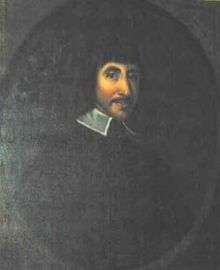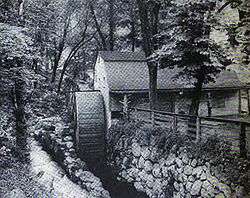John Winthrop the Younger
| John Winthrop the Younger | |
|---|---|
 | |
| Born |
12 February 1606 Groton, England |
| Died |
6 April 1676 (aged 70) Boston, Massachusetts Bay Colony |
| Signature | |
|
| |


John Winthrop the Younger (February 12, 1606 – April 6, 1676) was an early governor of the Connecticut Colony, and he played a large role in the merger of several separate settlements into the unified colony.
Biography
Winthrop was born in Groton, Suffolk, England, the son of John Winthrop, founding governor of the Massachusetts Bay Colony. He was educated at the Bury St. Edmunds grammar school, King Edward VI School, and Trinity College, Dublin, and he studied law for a short time after 1624 at the Inner Temple, London. He also accompanied the ill-fated expedition of the Duke of Buckingham for the relief of the Protestants of La Rochelle, and then travelled in Italy and the Levant, returning to England in 1629.[1]
In 1631, he followed his father to Massachusetts Bay Colony and was one of the assistants of the Colony in 1635, 1640, and 1641 and from 1644 to 1649.[1] He was the chief founder of Agawam (now Ipswich, Massachusetts) in 1633, then went to England in 1634. He returned in 1635 as governor of lands that had been granted to Lord Say and Sele and Lord Brooke, and he sent out a party to build a fort named Saybrook in their honor, located at the mouth of the Connecticut River. He then lived for a time in Massachusetts, where he devoted himself to the study of science and attempted to interest the settlers in the development of the colony's mineral resources.[1]
He was again in England in 1641–43, then returned to establish iron works at Lynn and Braintree, Massachusetts. In 1645, he obtained title to lands in southeastern Connecticut and founded New London in 1646, where he settled in 1650.[1] He built a grist mill in the town and was granted a monopoly on the trade for as long as he or his heirs maintained it. This was one of the first monopolies granted in New England.[2]
He became one of the magistrates of the Connecticut Colony in 1651, was governor of the colony in 1657–58, and again became governor in 1659, being annually re-elected until his death. During his tenure as Governor of Connecticut, he oversaw the acceptance of Quakers who were banned from Massachusetts. In 1662, he obtained the charter in England which united the colonies of Connecticut and New Haven. He was also one of the commissioners of the United Colonies of New England in 1675.
While in England, he was elected as a Fellow of the newly organized Royal Society, and he contributed two papers to their Philosophical Transactions: "Some Natural Curiosities from New England" and "Description, Culture and Use of Maize".[1] His correspondence with the Royal Society was published in series I, vol. xvi of the Massachusetts Historical Society's Proceedings.[1] He died in Boston on April 6, 1676 where he had gone to attend a meeting of the commissioners of the United Colonies of New England.[1][3]
Family
Winthrop's second wife was Elizabeth Reade (1615–1672).[4] Their eldest son Fitz-John Winthrop (1638–1707) served as major-general in the army, an agent in London for Connecticut (1693–1687), and governor of Connecticut from 1696 until his death in 1707.[1] Grandson John Winthrop, F.R.S. (1681–1747, by their second son Waitstill) married Ann Dudley, daughter of Joseph Dudley and granddaughter of Thomas Dudley, both governors of Massachusetts. This was one of a number of unions between the two families.
Winthrop's daughter Katharine (1711–1781) first married Samuel Browne of Salem, then Epes Sargent of Gloucester.[5] Her eldest child by Sargent was Paul Dudley Sargent, a colonel in the American War of Independence. Daughter Mary Winthrop (1712–1776) married Gurdon Saltonstall, Jr. (1708–1785), son of Connecticut Governor Gurdon Saltonstall (1666–1724). Gurdon and Mary were the parents of Dudley Saltonstall (1738–1796), a Revolutionary War naval commander most notable for his involvement in the ill-fated Penobscot Expedition.
Notes
- 1 2 3 4 5 6 7 8 Chisholm 1911, p. 736.
- ↑ Technical World Magazine. Armour Institute of Technology. 1910. pp. 96–97.
- ↑ Waters 1899, p. 75.
- ↑ "Archived copy". Archived from the original on 2006-09-01. Retrieved 2006-08-16.
- ↑ Sargent 1923, p. .
References
- Sargent, Emma Worcester (1923). Epes Sargent of Gloucester and his Descendants. Boston, Massachusetts: Houghton Mifflin.
- Waters, Thomas Franklin (1899). A sketch of the life of John Winthrop, the Younger. Cambridge, MA: Ipswich Historical Society. p. 75. OCLC 13130747. Retrieved 2010-01-07.

- Waters, T. F. (1899). Sketch of the Life of John Winthrop the Younger. Ipswich, Massachusetts.
External links


- Biographical sketch of Winthrop at State Library Web site
| Political offices | ||
|---|---|---|
| New office | Governor of the Saybrook Colony 1635–39 |
Succeeded by George Fenwick |
| Preceded by John Webster |
Governor of the Connecticut Colony 1657–58 |
Succeeded by Thomas Welles |
| Preceded by Thomas Welles |
Governor of the Connecticut Colony 1659–76 |
Succeeded by William Leete |